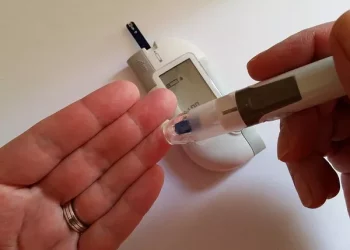After enjoying a meal, most people expect their energy levels to remain stable. However, for some individuals, eating actually triggers an unexpected drop in blood sugar levels – a phenomenon known as reactive hypoglycemia. This perplexing condition occurs when glucose levels fall below 70 mg/dL within 2-4 hours after eating, often leaving sufferers feeling shaky, sweaty, and fatigued just when they should be feeling nourished and satisfied.
Understanding the Blood Sugar Roller Coaster
The digestive process normally breaks down carbohydrates into glucose, which enters the bloodstream and triggers insulin release from the pancreas. In healthy individuals, this system maintains perfect balance. However, when this delicate equilibrium is disrupted, blood sugar can plummet unexpectedly after eating. The most common culprit is excessive insulin production in response to a meal, particularly one high in refined carbohydrates. This overshoot of insulin drives too much glucose out of the bloodstream and into cells, creating that sudden crash feeling.
The Refined Carbohydrate Trap
Modern diets filled with processed foods create the perfect storm for post-meal crashes. White bread, pastries, sugary cereals, and sodas digest rapidly, flooding the bloodstream with glucose. The pancreas responds by releasing a large bolus of insulin to manage this surge. However, this exaggerated insulin response often continues working even after the initial glucose has been cleared, resulting in hypoglycemia. These refined carbohydrates lack the fiber that normally slows digestion and moderates insulin release in whole foods.
The Missing Protein Factor
Many meals that cause subsequent crashes share a common flaw – they’re deficient in quality protein. A breakfast of toast with jam or a lunch of pasta with marinara sauce provides carbohydrates without the stabilizing influence of protein. When we include adequate protein from sources like eggs, chicken, fish, or legumes, the amino acids slow gastric emptying and moderate the insulin response. This creates a gentler, more sustained release of glucose into the bloodstream rather than the dramatic peaks and valleys caused by carb-heavy meals.
The Overlooked Role of Healthy Fats
Similarly, meals lacking in healthy fats often lead to quicker blood sugar drops. Fats from sources like avocados, nuts, seeds, and olive oil further slow carbohydrate absorption and provide sustained energy. A balanced meal containing all three macronutrients – carbohydrates along with protein and fat – creates optimal conditions for stable blood sugar maintenance. This triad works synergistically to prevent the rapid glucose fluctuations that trigger reactive hypoglycemia.
Gastroparesis
In some cases, an unexpected blood sugar drop after eating stems from gastroparesis – delayed stomach emptying. This condition, particularly common in people with long-standing diabetes, means food stays in the stomach longer than normal. When glucose finally enters the small intestine and gets absorbed, it may coincide with the peak action of insulin that was released earlier in response to the meal’s anticipated digestion. This mismatch in timing can result in hypoglycemia even hours after eating.
The Alcohol Paradox
Alcohol consumption with meals presents another pathway to postprandial hypoglycemia. While the body prioritizes alcohol metabolism, it suppresses glucose production from the liver. This effect, combined with alcohol’s ability to impair hypoglycemia awareness, creates a dangerous scenario where blood sugar can drop significantly without the usual warning symptoms. The situation worsens when alcoholic beverages contain added sugars, creating an initial spike followed by an exaggerated crash.
Exercise Timing Matters
Physical activity immediately after eating can precipitate hypoglycemia in susceptible individuals. Exercise increases insulin sensitivity and glucose uptake by muscles, which – when combined with meal-related insulin release – can drive blood sugar too low. This effect is particularly pronounced with intense or prolonged activity. Strategic timing of workouts (waiting 1-2 hours after meals) and having a small protein-rich snack beforehand can help prevent exercise-induced crashes.
Medication Side Effects
Certain medications can unexpectedly lower post-meal blood sugar. Diabetes medications like insulin and sulfonylureas are well-known culprits, but other drugs including some antibiotics, heart medications, and pain relievers may also have glucose-lowering effects. Even natural supplements like berberine or bitter melon can contribute to hypoglycemia in some individuals. Always review medications with a healthcare provider if experiencing unexplained blood sugar drops.
Hormonal Harmony and Glucose Control
Beyond insulin, several other hormones play crucial roles in post-meal glucose regulation. Cortisol, glucagon, epinephrine, and growth hormone all work in concert to maintain blood sugar stability. Dysregulation in any of these systems – such as in adrenal insufficiency or growth hormone deficiency – can manifest as reactive hypoglycemia. The intricate hormonal dance that follows eating requires precise coordination, and when one element is out of sync, crashes may occur.
The Surgical Connection
Individuals who have undergone bariatric surgery or gastric procedures are at particular risk for postprandial hypoglycemia, often referred to as dumping syndrome. When food moves too rapidly from the stomach to the small intestine, it triggers exaggerated insulin responses that aren’t properly matched to the actual glucose absorption. This mismatch creates a situation where insulin levels remain high even as blood glucose falls, leading to symptomatic hypoglycemia.
The Stress Factor
Chronic stress creates another pathway to post-meal crashes through its effects on cortisol. While cortisol initially raises blood sugar, prolonged elevation can lead to subsequent hypoglycemia as the body struggles to regain balance. Stress also influences food choices, often driving people toward quick-digesting carbohydrates that exacerbate blood sugar instability. Additionally, stress-induced poor sleep quality further disrupts glucose metabolism, creating a vicious cycle.
Preventing Post-Meal Crashes
The most effective strategy for preventing reactive hypoglycemia involves eating balanced meals containing protein, healthy fats, and fiber-rich carbohydrates at regular intervals throughout the day. Choosing low-glycemic index foods that digest slowly helps maintain stable glucose levels. Monitoring alcohol intake, managing stress, and timing exercise appropriately all contribute to better blood sugar control. For persistent cases, medical evaluation can identify underlying conditions that may require specific treatment approaches. With careful attention to dietary patterns and lifestyle factors, most people can successfully prevent those frustrating post-meal energy crashes.
Conclusion
post – meal blood sugar crashes (reactive hypoglycemia) have complex causes. Excessive insulin secretion triggered by refined carbohydrates, lack of protein and healthy fats in the diet, gastroparesis, alcohol consumption, improper exercise timing, medication side – effects, hormonal imbalances, surgical impacts, and stress can all disrupt normal blood sugar regulation. However, there are many solutions. Maintaining a balanced diet rich in protein, healthy fats, and fiber, choosing low – glycemic – index foods and eating regularly, controlling alcohol intake, reducing stress, scheduling exercise appropriately, and seeking medical evaluation when needed can effectively prevent post – meal blood sugar crashes. Understanding these reasons and actively improving lifestyle can enhance energy levels, allowing us to enjoy meals without the worry of blood sugar fluctuations.
























